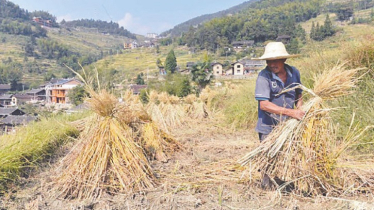
A farmer in Jhenaidah district has achieved remarkable success cultivating a hill rice variety, locally known as Jhum rice, on flat land. Abdur Rahim, a farmer from Ramnagar village in Kumrabaria Union under Sadar upazila, has drawn attention for his outstanding yield of the “Santu Pajam-21” rice variety. His success has sparked optimism among local farmers and inspired agricultural officials to explore new opportunities for rice cultivation in the plains.
Traditionally, Jhum rice is cultivated on hilly slopes across regions like Sherpur, Jamalpur, and Netrokona. The “Santu Pajam-21” variety, named after its innovator, farmer Santu Kumar Hajong from Nalitabari upazila of Sherpur, is one of the notable types grown in those regions. Abdur Rahim learned about this unique cultivation method through the internet and decided to experiment with it on his own fallow homestead land. He ordered just three kilograms of seeds online from Sherpur and planted them during the current Aman rice season.
“I bought three kilograms of seeds online, which arrived by courier from Sherpur,” Rahim told BSS. “I planted them on my homestead land this Aman season. The crop required less than 10 percent of the irrigation needed for regular Aman rice. The use of fertilizer and pesticides was also minimal, keeping production costs between Tk 7,000 and Tk 8,000 per bigha.”
Rahim said he cultivated the rice on 10 kathas of land and shared some seeds with his nephew and another farmer, who also experienced excellent yields. “This rice costs almost half as much to produce as traditional Aman rice but yields significantly more,” he said. “From my 10 kathas, I expect to harvest about 25 to 26 maunds of rice. Next season, I plan to cultivate it on a larger area.”
Another farmer from the same village, Tulu Mia, told BSS that he was initially skeptical about the crop’s potential. “I used to see Rahim’s field every day and thought the crop wouldn’t do well without much irrigation or fertilizer,” he said. “But now, seeing the high yield at such a low cost, we are truly surprised.”
Sadar Upazila Agriculture Officer Md. Nur-e-Nabi said the success of this cultivation has amazed the local agriculture department. “Unlike Aman rice, this variety requires very little irrigation, fertilizer, or pesticide. Pest attacks are also rare. Seeing such promising yields of this hill rice variety on flat land is truly remarkable,” he said.
He added that the Santu Pajam-21 rice, originally developed in Sherpur, is a high-yielding hybrid derived from the crossbreeding of native Pajam and Indian Ranjit (Paijam) varieties. “While it is typically grown as Jhum rice in hilly areas like Sherpur and Jamalpur during the Aman season, its adaptability to flatland conditions opens new doors for cultivation across the country,” he noted.





